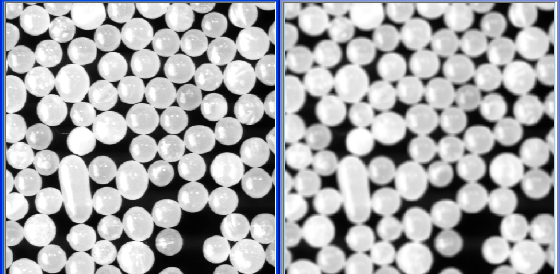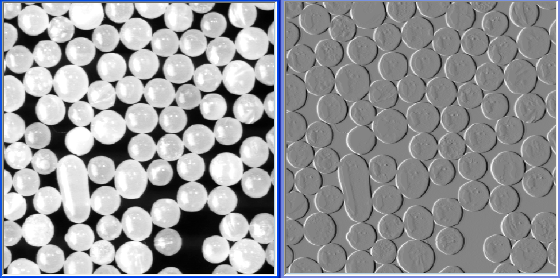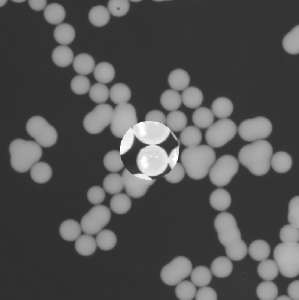Class SoImageFormulaProcessing
- java.lang.Object
-
- com.openinventor.inventor.Inventor
-
- com.openinventor.inventor.misc.SoBase
-
- com.openinventor.inventor.fields.SoFieldContainer
-
- com.openinventor.inventor.engines.SoEngine
-
- com.openinventor.imageviz.engines.SoImageVizEngine
-
- com.openinventor.imageviz.engines.arithmeticandlogic.arithmeticoperations.SoImageFormulaProcessing
-
- All Implemented Interfaces:
SafeDisposable
public class SoImageFormulaProcessing extends SoImageVizEngine
SoImageFormulaProcessingengine computes a new image combining one, two or three images using a given arithmetic formula. The formula used by this engine must be written according to the custom formula syntax.Some of the examples below can be implemented with an existing engine. In these cases using the appropriate native engine will be more efficient in term of performance.
Basic usage This engine accepts three input images which will be referenced as I1, I2 and I3 in the formula. Images two and three are optional and have to be provided if referenced in the formula.
For instance, the formula "if(I2==25, I1, 0)" allows to mask an input grey level image I1 with the blob of intensity 25 in a label image I2.

Usage with kernels Functions with a variable number of arguments such as min, max, avg, median, sum and product can be used in two ways :
- to combine images, for instance "min(I1, I2)"
- to compute kernel operations : "min(I1[7, 7])"
Kernels can be defined for these function with the following syntax: IN[x,y] in 2d case and IN[x,y,z] in 3d case. Where N references the used image (in [1,3]), and x,y and z corresponds to the expected kernel size.
For instance, the formula "mean(I1[7, 7])" allows to filter an image I1 by a box filter of size 7x7.

Usage with offsets Image offset can be defined in formula respecting following syntax : IN(x,y) in 2d case and IN(x,y,z) in 3d case. Where N references the used image (in [1,3]), and x,y and z corresponds to the offsets from the central current pixel. Symbols IN and IN(0,0) are strictly equivalent.
These offsets can be used to compute operations depending on pixels surrounding the current pixel to process.
For instance, a basic horizontal gradient operation can be written "I1(1, 0) - I1(-1, 0)"

Usage of image coordinates Image coordinates can be used in a formula: x, y and z represent the current pixel coordinates, ox, oy and oz the image origin and gx, gy and gz the image size.
For instance, these coordinates can be used to generate synthetic images. A basic line separation can be written as "if (3*x-100<y, 100, 0)":
 Coordinates can also be used to handle more complex case such as
"if ((x- (ox+gx)/2)*(x-(ox+gx)/2)+(y-(oy+gy)/2)*(y-(oy+gy)/2)<=50*50, I1, I2)"
Coordinates can also be used to handle more complex case such as
"if ((x- (ox+gx)/2)*(x-(ox+gx)/2)+(y-(oy+gy)/2)*(y-(oy+gy)/2)<=50*50, I1, I2)"

File format/default:
ImageFormulaProcessing {
computeMode MODE_AUTO inImage NULL inImage2 NULL inImage3 NULL inFormula "" dataType UNSIGNED_CHAR
Library references: imageformula
-
-
Nested Class Summary
Nested Classes Modifier and Type Class Description static classSoImageFormulaProcessing.DataTypes-
Nested classes/interfaces inherited from class com.openinventor.imageviz.engines.SoImageVizEngine
SoImageVizEngine.ComputeModes, SoImageVizEngine.EventArg, SoImageVizEngine.Neighborhood3ds
-
Nested classes/interfaces inherited from class com.openinventor.inventor.Inventor
Inventor.ConstructorCommand
-
-
Field Summary
Fields Modifier and Type Field Description SoSFEnum<SoImageVizEngine.ComputeModes>computeModeSelect the compute Mode (2D or 3D or AUTO) .SoSFEnum<SoImageFormulaProcessing.DataTypes>dataTypeArithmetic format.SoSFStringinFormulaFormula to apply on image(s).SoSFImageDataAdapterinImageThe input image.SoSFImageDataAdapterinImage2Optional image : enter image or let field empty.SoSFImageDataAdapterinImage3Optional image : enter image or let field empty.SoImageVizEngineOutput<SoSFImageDataAdapter,SoImageDataAdapter>outImageThe output image.-
Fields inherited from class com.openinventor.imageviz.engines.SoImageVizEngine
onBegin, onEnd, onProgress
-
Fields inherited from class com.openinventor.inventor.Inventor
VERBOSE_LEVEL, ZeroHandle
-
-
Constructor Summary
Constructors Constructor Description SoImageFormulaProcessing()Constructor.
-
Method Summary
-
Methods inherited from class com.openinventor.imageviz.engines.SoImageVizEngine
abortEvaluate, isEvaluating, startEvaluate, waitEvaluate
-
Methods inherited from class com.openinventor.inventor.engines.SoEngine
copy, getByName, getOutput, getOutputName
-
Methods inherited from class com.openinventor.inventor.fields.SoFieldContainer
copyFieldValues, copyFieldValues, enableNotify, fieldsAreEqual, get, getAllFields, getEventIn, getEventOut, getField, getFieldName, hasDefaultValues, isNotifyEnabled, set, setToDefaults
-
Methods inherited from class com.openinventor.inventor.misc.SoBase
dispose, getName, isDisposable, isSynchronizable, setName, setSynchronizable, touch
-
Methods inherited from class com.openinventor.inventor.Inventor
getNativeResourceHandle
-
-
-
-
Field Detail
-
computeMode
public final SoSFEnum<SoImageVizEngine.ComputeModes> computeMode
Select the compute Mode (2D or 3D or AUTO) . Default is MODE_AUTO
-
inImage
public final SoSFImageDataAdapter inImage
The input image. Default value is NULL. Supported types include: grayscale binary label color image.
-
inImage2
public final SoSFImageDataAdapter inImage2
Optional image : enter image or let field empty. This parameter is optional. Default value is NULL. Supported types include: grayscale binary label color image.
-
inImage3
public final SoSFImageDataAdapter inImage3
Optional image : enter image or let field empty. This parameter is optional. Default value is NULL. Supported types include: grayscale binary label color image.
-
inFormula
public final SoSFString inFormula
Formula to apply on image(s). See Custom formula syntax for how to use a formula. Default value is "".
-
dataType
public final SoSFEnum<SoImageFormulaProcessing.DataTypes> dataType
Arithmetic format. . Default is UNSIGNED_CHAR
-
outImage
public final SoImageVizEngineOutput<SoSFImageDataAdapter,SoImageDataAdapter> outImage
The output image. Default value is NULL. Supported types include: grayscale binary label color image.
-
-